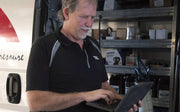
Reciprocating Air Compressors
About Our Reciprocating Air Compressors
We sell, install and service high-quality reciprocating (piston-style) air compressors from PneuTech and other national brands, including Ingersoll Rand and Saylor Beall.
Reciprocating air compressors are an older technology, but they have their advantages. They represent the lowest initial cost. Typically, reciprocating compressors are up to 30HP and designed for no more than 70% duty cycle. They tend to run hotter than rotary screw compressors and are generally less energy efficient. But reciprocating air compressors can still be a great choice with some significant advantages for the right users, including:
- Lower initial capital investment
- Simple maintenance
- Can be run in sheltered outdoor or dirty indoor environments
- Best for intermittent applications such as manual tools, blow-off, tire inflation, etc.
These workhorses are generally found in dirty environments, automotive service centers, or applications that demand infrequent air use.

Get in Touch Today
We are here to serve your compressed air system needs 24/7/365. Call or click today!
FAQ
How does a reciprocating air compressor work?
A reciprocating air compressor (also known as a piston-type air compressor) uses pistons driven by a crankshaft to compress the air. This technology has been used since the dawn of the industrial revolution to compress air. It is a positive displacement technology, meaning they increase the pressure on air to compress it. “Reciprocating” means to move back and forth; this type of compressor works through the back-and-forth movement of the piston.
- In the intake cycle, the piston moves downward through the cylinder. This creates a vacuum between the piston head and the top of the cylinder, which pulls atmospheric air in through the inlet valve.
- As the piston moves back upward, the inlet valve closes to trap air in the cylinder. The action of the piston squeezes the air into a smaller volume, raising the pressure and compressing it.
- The rising pressure inside the cylinder triggers a discharge spring to open. The compressed air exits through the discharge valve.
- A reciprocating compressor cycles between “loaded” and “unloaded” time during a complete cycle. The “loaded” portion of the cycle is the time during which the compressor is actively making air. During the “unloaded” portion of the cycle, the compressor is resting.
- A reciprocating compressor is not designed to make air continuously. The duty cycle is the portion of time the air compressor is loaded out of a full cycle. Most reciprocating air compressors are designed to operate at a duty cycle of around 30%; some can operate at a duty cycle up to 70%. Be sure your air compressor is operating within its duty cycle to extend its lifespan.
Learn more about reciprocating air compressors. Talk to a Fluid-Aire Dynamics compressed air expert to find out if a reciprocating air compressor is right for you.
What is a reciprocating air compressor used for?
Piston compressors (also called reciprocating compressors) are the perfect machine for small manufacturing facilities, body shops, and other light industrial applications. This style of air compressor is often found in small garages and even for home DIY applications. Some typical applications are:
- Pneumatic power tools
- Blow-off/cleaning
- Pneumatic nail guns
- Sandblasting and sanding
- Manual spray paint
- Cutting and welding equipment
- Material finishing
What is the difference between a single-stage and dual-stage reciprocating compressor?
Single-stage reciprocating compressors have one piston to compress the air. Air goes from the piston cylinder to a storage tank. In a dual-stage reciprocating compressor, there is a second piston. After air is compressed in the first cylinder, it enters the second piston cylinder, where it undergoes another round of compression. There may be an intercooler between the two piston stages. After the air completes the second stage of compression, it goes through a cooler and then is sent to the storage tank.
Most piston-style compressors are single-stage, especially those used for home use or in smaller shops. Single-stage compressors are suitable for pressurizing air up to ~100 PSI, which is adequate for most pneumatic tools and basic shop operations. Dual-stage compressors can produce significantly more power. The dual-stage process allows these compressors to produce more air and produce it on a more continual basis. This makes them more appropriate for larger industrial applications. They are also considerably more expensive to buy and operate.
A dual stage air compressor is different from a duplex air compressor, which has two individual compressor pumps and motors mounted on a single tank. A duplex air compressor provides 100% back-up power or additional air power for larger jobs.